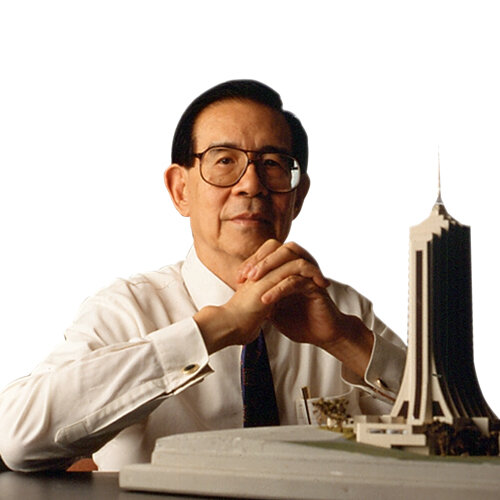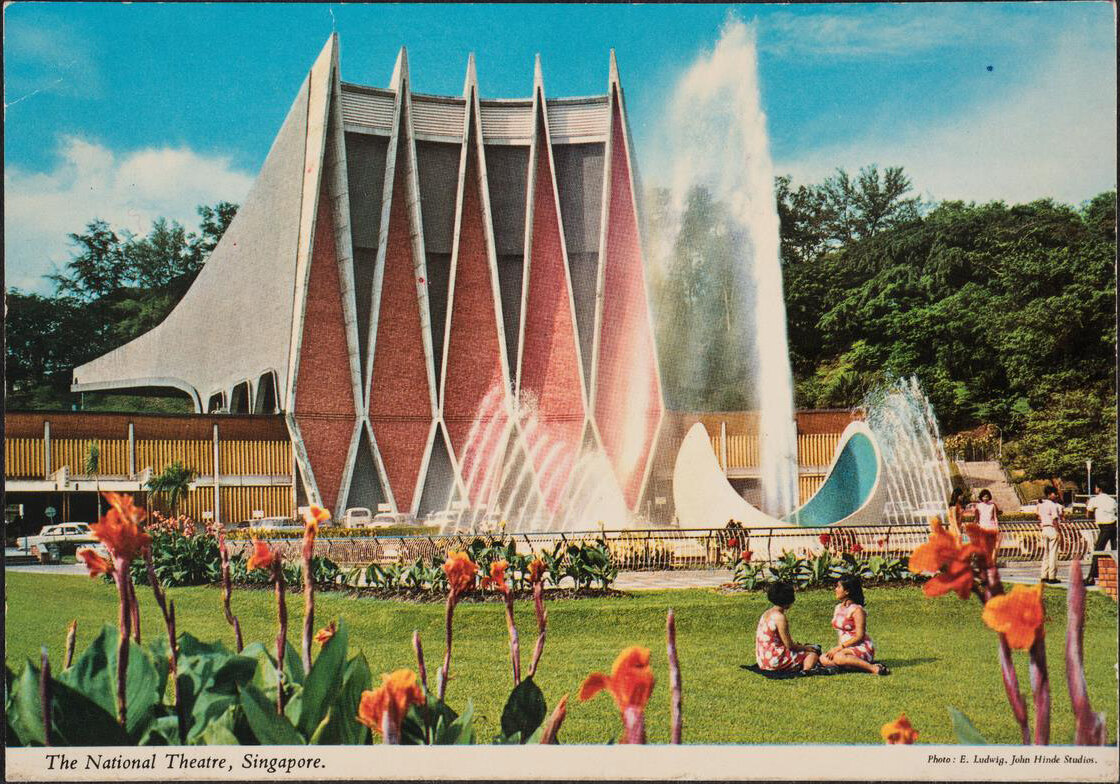Alfred Wong Hong Kwok
Photo: AWP Architects
Alfred Wong (1930– ) belongs to the first generation of post-war overseas educated local architects, alongside contemporaries such as Lim Chong Keat and C.A.V. Chew. His practice, Alfred Wong Partnership (later incorporated as AWP Pte. Ltd.), spans five decades, traversing Singapore’s key political milestones from the late colonial period to merger with Malaysia to post-independence. Producing wide-ranging works that include residences, schools, institutional buildings, churches, and hotels, his firm is responsible for a number of significant buildings such as the National Theatre (1963), Hotel Malaysia (1974, later Marco Polo Hotel), and the Singapore Polytechnic (1979). Meticulous planning, elegant spatial proportions, thoughtful use of materials, and sensitive detailing are hallmarks of his most successful works. Wong continues to practise and plays an active role as chairman of AWP Pte. Ltd.
Wong, who was born in Hong Kong, is the grandson of Wong Ah Fook, the prominent entrepreneur and banker from Canton, China, who made his fortune in Singapore and Malaya in the building and plantation industries in the nineteenth century. The young boy came to Singapore at a young age, and enrolled at St Anthony’s Catholic School in Queen Street. Though his education was interrupted by the Japanese Occupation, he completed his secondary schooling immediately after the war in 1946.
Wong pursued his architectural education at the University of Melbourne, graduating with honours in 1953. He was part of the pioneer cohorts of the Faculty of Architecture, staffed by luminaries of Australia’s Modern Movement such as the founding chairman, Brian Lewis, and lecturers Roy B. Grounds and Robin G.P. Boyd. Here Wong imbibed fundamental tenets of modernist design, such as rational planning, climatic responsiveness, expressive construction design, and human scale — principles that would underscore his architectural repertoire.
On his return to Singapore, Wong joined the largest architectural firm here, Swan & Maclaren, where he stayed for four years. He was involved in the design of the Prince Edward Road campus of the Singapore Polytechnic and the University of Malaya in Kuala Lumpur. Working in the sprawling drafting room of the expatriate-dominated firm, Wong was acutely aware of his career limitations, and the inequalities implicit in the colonial milieu. After obtaining his architect’s qualification as an associate of the Royal Institute of British Architects (RIBA) in 1956, Wong left the following year to set up his own firm, Alfred Wong Partnership.
The next few years saw a tumultuous period in Singapore’s history as the city geared up for internal self-government and decolonisation. Wong, charged with the prevailing sense of national pride and idealism, joined others in the search for a new architectural identity. The firm’s early works were mainly private houses for an emerging local professional class that included civil servants, doctors, and engineers — people not unlike Wong himself. He explored designs responsive to the tropical climate and which also suited modern life. His major breakthrough came when he won the first prize in an invited design competition for the National Theatre in 1960 (since demolished), triumphing over established large practices such as Van Sitteren & Partners, and Ng Keng Siang. This was an ambitious and politically significant cultural project to commemorate Singapore’s internal self-government. The distinctive five-pointed façade anchored a daring cantilevered roof that soared over the tropical, open-sided performance venue. A significant national icon, it hosted “people’s concerts” (aneka ragam rak’yat), international performances, university convocations, and National Day rallies up till the mid-1980s.
Concurrently, Wong designed a number of churches, exquisitely realised in the modernist idiom. He developed and refined central ideas about the new architecture that was relevant to the local context and its times. Funded by donations, the shoestring budgets for these buildings — such as St Ignatius Church in King’s Road (since demolished), and Church of St Francis Xavier in Serangoon Gardens — did not deter the architect from creating attractive and dignified spaces. In his Church of St Bernadette in Zion Road, precast ventilation screens, proprietary aluminium sun-breakers, and pivoted metal and glass windows form a permeable building envelope for natural illumination and cross ventilation. Wong’s innovative use of mass-produced building components greatly reduced cost and improved efficiency of construction. An awe-inspiring place of worship, the church received conservation status in 2009.
Following independence, Singapore embarked on an ambitious urban renewal, housing, and industrialisation programme. Wong dubbed these heady nation building years a “heroic period” that presented opportunities for local architects to prove their mettle. His firm took on commissions to design several pioneer factory complexes in the fledgling Jurong industrial area, including the Singapore Mint complex. A major work of the late sixties was Hotel Malaysia (later renamed Marco Polo Hotel and since demolished) at the junction of Tanglin and Holland Roads. This was the first modern hotel of an international standard in Singapore, built in anticipation of the development of her tourism industry. The imageable urban landmark was distinguished by the graceful sweep of its curved blocks, housing 300 guest rooms and the largest banquet hall then in Singapore. Its lush ethnic-themed interiors projected a sophisticated image of rich regional cultures, modern living, and urbane sensibilities.
Wong’s works from the late 1970s onwards took on an increasingly “internationalist” outlook that mirrored Singapore’s aspirations to become a “global city”. His younger sibling, Edward Wong, became a co-director of the firm, which completed large-scale projects that included Peninsula Plaza (1981), PSA Keppel Distripark (1995), and Samsung Hub office tower in Church Street (2001). Departing from the prevailing trend among contemporary corporate practices, these large-scale commercial projects were designed without the involvement of foreign design consultants. Wong’s practice has expanded regionally since the late 1990s, with overseas branch offices in other Southeast Asian countries, China, and the Middle East.
Wong also played an active role in the development of the architectural profession, especially in accreditation and education issues. He was one of the founding members of the Singapore Institute of Architects (SIA) in 1961, subsequently serving four terms as its president from 1963–66, through the crucial period of Singapore’s political transition, and remaining a council member till 1972. As a representative on the Board of the Singapore Polytechnic and, later, the Board of Governors in the University of Singapore, he was party to the conversion of the local architecture course from a diploma to a full-fledged degree course in the early 1970s. In addition, Wong has served in numerous advisory roles with statutory boards and government ministries since the early days of his career. Most recently, he was chairman of the Preservation of Monuments Board for six years, from 2003–09, overseeing the setting up of the Monuments Inspectorate. For his lifelong contribution to the local architectural profession and public service, Wong became the inaugural recipient of the Singapore Institute of Architects Gold Medal in 1998, and was conferred the Public Service Star (BBM) by the Government of Singapore in 2005.
Last modified on 5 May 2021. Reproduced from Ho Weng Hin and Tan Kar Lin, “Wong Hong Kwok, Alfred”; in Leo Suryadinata, ed., Southeast Asian Personalities of Chinese Descent: A Biographical Dictionary, Volume I (Singapore: ISEAS Publishing, 2012), 1278-80, with the kind permission of the authors and publisher, ISEAS - Yusof Ishak Institute.
References
Righetti, Paolo. Alfred Wong Partnership: Innovation and Knowledge. Milan: L’Arcaedizioni, 1999.
Seow, Eu Jin. “Architectural Development in Singapore”. Academic thesis presented for the Doctor of Philosophy degree, University of Melbourne, 1974.
Tan, Kok Meng. “1998 SIA Gold Medal Award: Alfred Wong Speaks to the Singapore Architect”. In Singapore Architect, no. 200. Singapore: Singapore Institute of Architects, 1998.
Wong, H.K., Alfred. “A Brief Review of Our Recent Architectural History”. In Singapore Institute of Architects, Contemporary Singapore Architecture 1960s–90s. Singapore: Singapore Institute of Architects, 1998.



